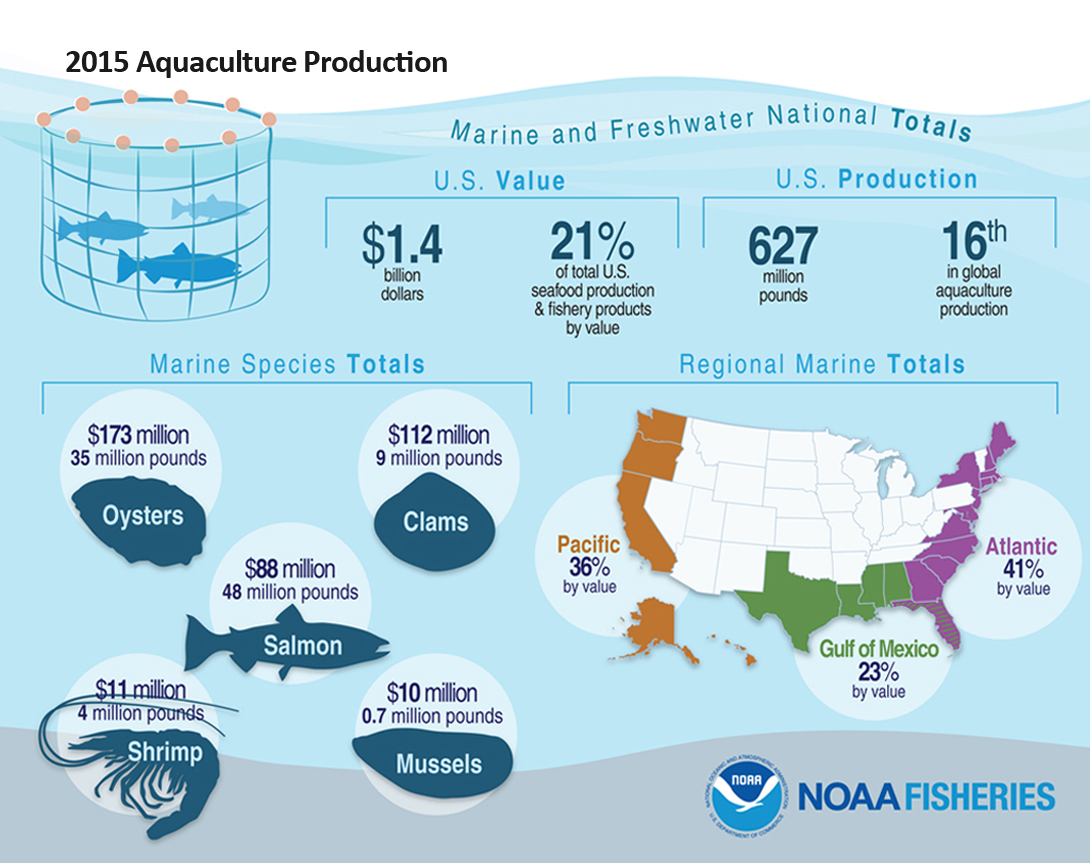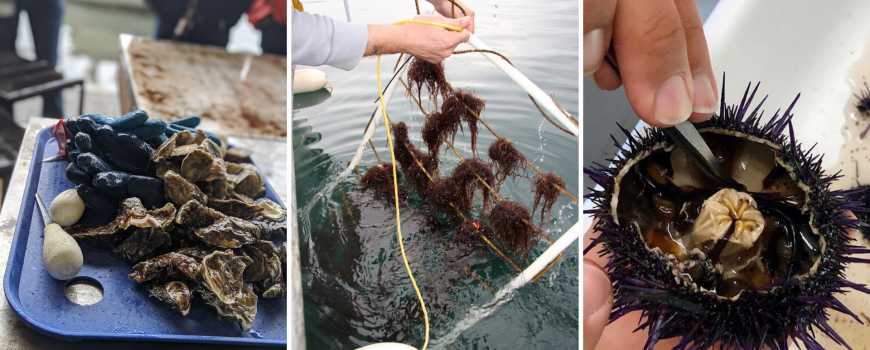What is aquaculture?
Aquaculture is the farming of fresh and saltwater animals or plants. Farmed seafood has been around for thousands of years, and in 2018, worldwide farmed seafood exceeded that produced from wild-caught fisheries.
While aquaculture may be most well-known as a way of producing seafood for human consumption, it also is used to produce organisms for other purposes including stock restoration and enhancement, ornamental fish for aquariums, research, and products like pearls and shells.
Why is there interest in expanding aquaculture now?
Research has found that farmed seafood can be a resource-efficient way to meet the growing demand for protein worldwide, according to a 2018 FAO report. Aquaculture supports domestic seafood production, and creates jobs and businesses in coastal and inland communities. It complements wild fisheries, also providing local, fresh, and sustainably produced seafood.
Is aquaculture harmful to the environment?
Like any human activity, aquaculture does affect the environment. Advances in technology and management techniques over the last two decades have helped replace some practices that caused environmental concern in the past with better alternatives. Modern technology, net pen engineering, health management programs, and appropriate siting can minimize environmental impacts of ocean farming of fish, shellfish, and aquatic plants. Recent studies have shown that farmed seafood generally has a lower environmental footprint compared to beef, lamb, and pork, and is comparable to poultry.
In the United States, and California in particular, federal and state agencies work with growers to develop and maintain practices that protect water quality and the environment.
Can aquaculture be good for the environment?
Studies have found that well-managed shellfish farming can be beneficial by:
- improving water quality as the animals filter the water when they feed,
- increasing the number of different species in an area, and
- increasing the complexity of the habitat thereby supporting more organisms.
There is some research that suggests ocean net-pens for finfish can improve recreational fishing nearby.
Aquaculture can also benefit the environment or reduce the environmental impact of other land-based production systems. For example, projects are ongoing in California that use aquaculture to help restore populations of endangered species such as white abalone and native Olympia oysters. There is also research exploring whether seaweed aquaculture could be used as a feed supplement for livestock in order to reduce their environmental impact.

Is farm-raised seafood from California safe to eat?
Yes, farm-raised seafood in the United States must meet strict health standards set by federal and state agencies. Drugs and hormones cannot be used to promote stock growth. Before farm-raised seafood, including oysters, clams and mussels can be sold, they and the water they are grown in are monitored for a number of naturally occurring pathogens that may make consumers sick. Seafood processors and packers also must comply with numerous federal health requirements.
What seafood is being grown in California?
Many saltwater and freshwater species including oysters, abalone, mussels, clams, seaweed, channel catfish, tilapia, sturgeon, striped bass, and rainbow trout are being grown in the state for food. Other aquaculture products like scallops, California yellowtail, and California halibut are under development.
What other types of aquaculture are happening in California?
Many species of freshwater fish are grown for stocking lakes to support recreational fisheries. Some species like salmon, white abalone, and oysters are being farmed to a certain size and then released in the wild to restore or enhance existing populations. Tropical species like clownfish and coral, and freshwater koi also are being farmed on a small scale to supply aquarium and pond hobbyists.
Does California aquaculture occur only in saltwater?
No, not all aquaculture farms are in oceans and bays. In fact, most farmed fish are grown inland at freshwater farms. Typically, land-based hatcheries are used to breed and raise young for both salt and freshwater species. The young are then grown in tanks and ponds on land, or on lines or in cages in bays and ocean areas. Globally, inland freshwater aquaculture produced 64% of the world’s farmed food fish in 2016, with the U.S. a major producer of catfish.
Where are seafood farms located in California?
Currently, aquaculture facilities that produce food products are located up and down the coast, and in ponds and tanks inland. For example, oysters are grown in Humboldt, Tomales, Morro, and San Diego Bays, and in Agua Hedionda Lagoon just north of San Diego. There are mussel farms in the Santa Barbara Channel and off Long Beach, with a permit pending for significant expansion of mussel farming off the coast of Ventura. Abalones, a popular delicacy, are raised both on land in Santa Barbara, Cayucos (near Morro Bay), Davenport (near Santa Cruz) and in the ocean under a wharf in Monterey. Tilapia, striped bass, carp, catfish, and bass are being raised in the Coachella Valley, with sturgeon farmed near Sacramento.
Where is California farmed seafood sold?
Oysters and mussels can be found in many coastal restaurants, grocery stores and farmers markets. Abalone, which is coveted by seafood connoisseurs for its extremely rich, flavorful, highly prized meat, is often sold at high-end restaurants. Abalone is only available from abalone farmers, as commercial and recreational fisheries have been closed. Sturgeon caviar can be purchased online and at restaurants. Most freshwater fish like catfish and tilapia make their way to live fish Asian markets and restaurants.
What is the market for aquaculture, and how do products get to market?
In the US, 70% of seafood is eaten outside the home. For farmed seafood, that proportion is probably even more. In particular, marine aquaculture products tend to be mostly luxury foods like oysters, clams, and salmon, which people are even more likely to eat at restaurants.
Aquaculture farms often sell directly to restaurants or through a wholesaler. Usually, people eat these products fresh, rather than frozen and thawed.
To get to their customers, aquaculture farmers may ship their goods thousands of miles all over the country and even abroad. Usually, they use some kind of insulated packaging to prolong freshness. Since it’s important for seafood to be fresh, farmers use commercial shipping companies to ensure rapid delivery.
What is the economic value of aquaculture products produced in California and the U.S.?
According to the USDA's Census of Aquaculture (2012), the industry generated ~$102 million in sales and distribution in California and ~$1.55 billion in sales and distribution in the U.S.
Do you have a question about aquaculture in California? Email us at casgcomms@ucsd.edu and we may answer it here.
-Written by Caitlin Coomber
Reviewed by California Sea Grant Extension Specialists:




